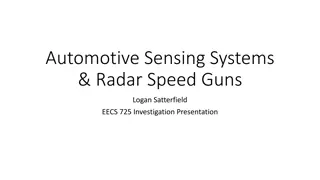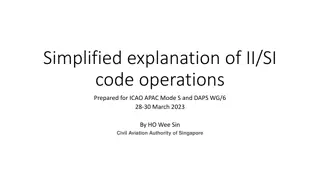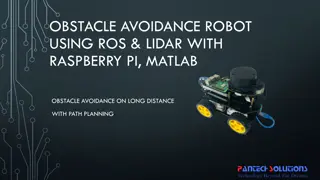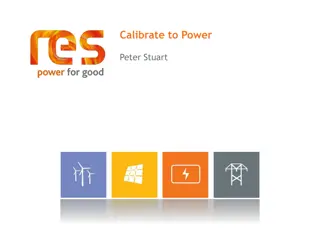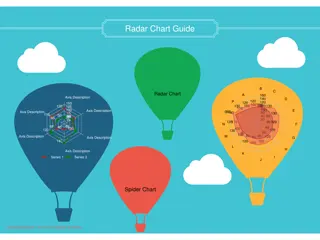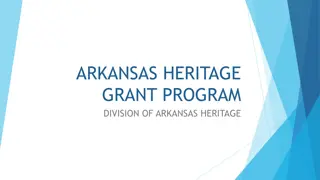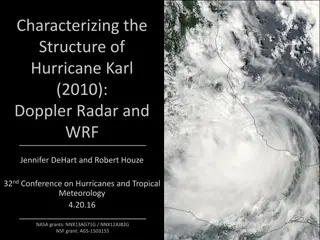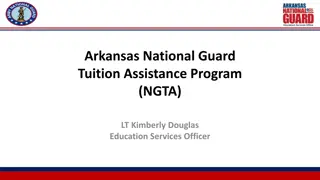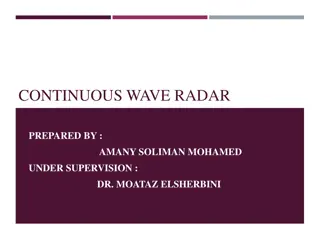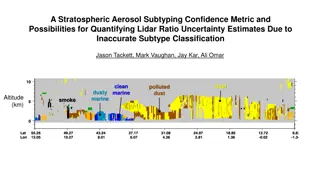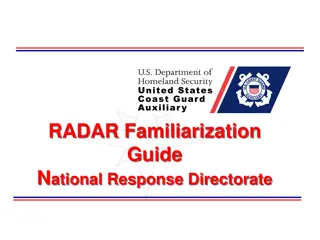Radar and Lidar Course Legal Requirements in Arkansas
This content provides information on the legal considerations, training requirements, and regulations for radar and lidar operators in Arkansas, as well as the criteria for CLEST certification. It covers statutes related to operator qualifications, speed trap laws, and the issuance of operator certificates. Officers must meet training requirements and obtain certification to legally operate radar units. The content emphasizes the importance of adherence to regulations to ensure the validity of law enforcement actions.
Download Presentation

Please find below an Image/Link to download the presentation.
The content on the website is provided AS IS for your information and personal use only. It may not be sold, licensed, or shared on other websites without obtaining consent from the author.If you encounter any issues during the download, it is possible that the publisher has removed the file from their server.
You are allowed to download the files provided on this website for personal or commercial use, subject to the condition that they are used lawfully. All files are the property of their respective owners.
The content on the website is provided AS IS for your information and personal use only. It may not be sold, licensed, or shared on other websites without obtaining consent from the author.
E N D
Presentation Transcript
Radar / Lidar Course Instructor Ronnie Poole Revised: 01/18 1
Unit1 Legal Considerations 2
Arkansas Statutes 12-9-403 Establishes the training requirements of an operator. 3
Arkansas Statutes 12-9-404 States that any officer not meeting the requirements set forth by statute cannot legally operate a radar unit. If an unqualified operator does take any official action it will be held invalid. 4
Arkansas Statutes Arkansas Speed Trap Law 12-8-401 Arkansas State Police are authorized to investigate and determine if a municipality is abusing Police power by: 5
12-8-401 Cont. a. Generating revenue from certain traffic offenses on state highways and that generated revenue exceeds 30% of the municipalities total expenditures (with certain exemptions.) More than 50% of the citations issued are for speeds less than 10 MPH over. 6
CLEST CERTIFICATION The Commission established the following radar certification criteria under regulation 1015: The operator must have completed an approved course. 7
CLEST CERTIFICATION Full-time, Part-time I, Part-time II and Auxiliary Officers, who have completed the approved training for their level of certification shall be eligible for certification as a Police Traffic Radar Operator. 8
CLEST CERTIFICATION An operator certificate will be issued to the officer after applying for radar certification. Radar Operator cards will no longer be issued after 3-1-2016. 9
CLEST CERTIFICATION Any certificates or I.D. cards are the property of the commission and can be recalled. The operator certificate, as well as the instructor certificate, is non-expiring unless the officer is separated from law enforcement for more than 3 years. 10
CLEST CERTIFICATION Radar refresher is no longer required. The course length for new operators is 8 hours. 11
Detection Devices These devices give advance warning that a Radar is operating in the area. Radar detectors are NOT illegal in our state. 12
Basic Speed Rule 27-51-201 No person shall operate a vehicle in excess of a speed that is safe and prudent for the conditions that exist at the time. The basic speed rule is intended to prohibit unsafe speeds. 13
Basic Speed Rule The basic speed rule is not dependent on posted speed limits. Violations of the basic speed rule require proof that the speed was unreasonable and imprudent for the existing conditions. 14
Basic Speed Rule Conditions These existing conditions include: Road conditions. Traffic density and volume. Hazards ( road construction etc. ) Weather conditions. Visibility Vehicle conditions. 15
Absolute Speed Laws 27-51-201/216 Absolute speed is a speed limit that is in force regardless of the environmental conditions. Absolute speed rules prohibit driving faster and sometimes slower than predetermined limits. Absolute speed rules depend upon posted or mandated speed limits. 16
Absolute Speed Laws The premise of the absolute speed rule is that the predetermined speed limit is the maximum and sometimes the minimum reasonable and prudent speed. 17
Basic/Absolute Rule Overlap The basic and absolute speed rules can overlap. A driver can drive within the absolute speed limit but violate the basic speed rule. 18
Introduction of Scientific Evidence Evidence derived from complex mechanical devices is typically challenged by the defense as to its accuracy and reliability. The prosecution must establish this reliability by the use of expert witnesses. 19
Introduction of Scientific Evidence The court can dispense with expert testimony only if the scientific principle underlying the new device has been given judicial notice. Judicial notice extends only to the principle, it does not apply to any particular device 20
Introduction of Scientific Evidence The following are landmark court cases that have established judicial notice or established proper operating and testing procedures. 21
Judicial Notice In June 1955, the Supreme Court of New Jersey took judicial notice of the Doppler radar. This case was State v. Dantonio. In this case the court affirmed that the radar concept was generally known and understood by all reasonably informed individuals. 22
Judicial Notice The Arkansas State Supreme Court took judicial notice of Doppler radar in 1959, with the case Everight v. City of Little Rock. In addition to taking judicial notice, this case established that it is still necessary to prove the accuracy of the particular device employing the Doppler principle. 23
Judicial Notice (Tests) No court can accept every radar device as always being completely accurate. What the court may do is take judicial notice of certain methods and techniques for determining accuracy. 24
Judicial Notice (Tests) In Thomas v. City of Norfolk The Supreme Court of Virginia ruled that it would be sufficient to test the radar unit at the beginning and end of each duty shift. In State v. Tomanelli the Supreme Court of Connecticut established the use of the tuning fork as a reliable test of accuracy. It is important that the court noted that the tuning fork s Accuracy may be questioned. 25
Operator Qualifications In Honeycutt v. Commonwealth The Kentucky Court of Appeals stated that an operator must be able to: a. Properly setup a radar Unit b. Test a radar unit. c. Read a radar unit. 26
Honeycutt Vehicle Identification Honeycutt also dealt with vehicle identification. The court established a procedure for vehicle identification. 27
Honeycutt Vehicle Identification The officer must establish, through direct visual observation, that a vehicle represents a potential violation. The initial estimate is verified by checking the speed displayed by the radar unit. If these two pieces of evidence agree, the operator has sufficient cause to believe the target vehicle is the violator. 28
Honeycutt Vehicle Identification The visual estimate must be considered the primary evidence with the radar reading being considered secondary. While not mandated by case law, the use of the Doppler tone is strongly recommended as an integral part of tracking history. 29
Special Requirements Moving RADAR In State v. Hanson the Wisconsin Supreme Court addressed several issues on the use of moving radar. The issues are: The operator must have proper training and experience in the operation of moving radar. The radar unit must have been in proper working order when the violation took place. 30
Special Requirements Moving RADAR The radar unit was used where road conditions would distort readings as little as possible. The patrol car s speed was verified. The unit was tested within a reasonable time before and after the arrest. 31
UNIT2 Principles of Radar Speed Measurement 32
Doppler Principle In 1842, Christian Doppler discovered that relative motion causes a signal s observed frequency to change by studying sound waves. This observation is now referred to as the Doppler Principle . 33
Doppler Principle This principle was arrived at by Doppler listening to a train whistle as the train approached him. As the train approached the whistle sounded high pitched. As the train passed the observer the whistle sounded normal. 34
Doppler Principle As the train went away from the observer the whistle sounded low pitched. When the principle is applied to traffic radar the following observations apply: 35
Doppler Principle Observations If relative motion brings the objects closer together, the reflected frequency will be increased. If relative motion takes the objects further apart, the reflected frequency will be decreased. How much the reflected frequency is changed is determined by the speed of the relative motion between the two objects. 36
Relative Motion Objects Moving Towards - Reflect At Higher Frequency Transmitted Frequency Object Moving Toward Transmitter Reflected Frequency Objects Moving Away - Reflect At Lower Frequency Transmitted Frequency Object Moving Away Transmitter Reflected Frequency 37
Relative Motion Relative motion occurs when: The radar stands still and the object moves. The radar moves and the object stands still. Both the radar and the object are moving, as long as they both move at different speeds or in different directions. 38
Radar Uses Radio Waves Basic principle applies to: Sound Waves Light Waves Radio Waves 39
Radio Waves From the transmitter, radio waves spread out in a predictable manner at a known speed, the speed of light (186,282 mps). Given all these known qualities useful information can be gained by calculating the difference between the original transmission and its reflection. 40
Early Radar In the 1930 s radar was used to detect aircraft. In 1947 law enforcement began to use radar for speed measurement. Radar Frequencies: X-Band, K-Band, Ka-Band In 1972 Moving RADAR was developed. 41
RADAR RAdio Detection And Ranging 42
Radar Operation Radio-frequency is generated by a transmitter. An antenna forms the energy into a beam. The beam is transmitted into space. 43
Radar Operation When the energy or signal strikes an object, a small amount of energy is reflected back to the antenna. From the antenna, the reflected signal is sent to the receiver, where, if the signal is strong enough, it is detected. 44
Radar Operation To measure speed, a radio signal s frequency is changed when the signal is reflected from a target that is moving at a different speed from that of the radar unit. This change or shift is known as Doppler Shift 45
Radar Operation By measuring the amount of the frequency shift, the radar is able to calculate and display the target speed in miles per hour and generate a corresponding Doppler tone. The higher the speed, the higher the pitch. The lower the speed, the lower the pitch. 46
WAVE, WAVELENGTH Peak A to B = Wavelength B A Valley 47
Wave Concept Every radio signal has two related characteristics that distinguish it from every other signal. Wave length - the distance from the beginning of the peak to the end of the valley. A wave usually consists of many cycles not just one. 48
Wave Concept Frequency the number of the recurrences of a signal during one second of time. 49
Wave Concept Every radio signal has its own particular frequency and wave length. The speed of a radio signal is constant. The signal travels at the speed of light, 186,282 miles per second. 50






